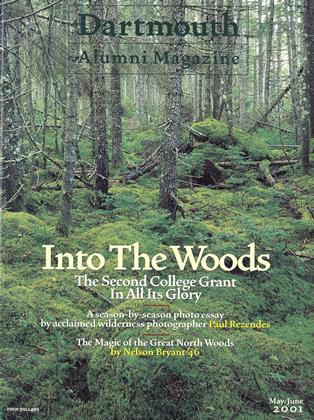A User's Guide In its early history, Dartmouth College received several parcels of land, including the Landaff Grant, the Wheelock Grant and the First College Grant, also known as the Clarksville Grant. Many of these tracts were either sold by the College, settled by homesteaders or argued over in court.
College trustees, dissatisfied with the value and sales of these grants, petitioned the New Hampshire legislature for more land. In 1807 the state offered Dartmouth a township of 27,000 acres (roughly a third larger than Manhattan) in northeastern New Hampshire's Coos County. Since then it's been known as the Second College Grant.
It's rugged country. The Swift Diamond and Dead Diamond rivers run through it, and the three Diamond Peaks (highest elevation: 2,040 feet) stand as its most prominent feature. Today the Grant is valuable to the College as a revenue source through timber harvesting. But it also serves as a sort of wild north campus. Students, faculty and alumni take advantage of the wilderness in a variety of ways. "There are a million things going on up here," says College forester Kevin Evans. For example:
TIMBER HARVESTING Under the guidance and supervision of Evans, harvesting now runs at about 8,000 cords per year, fluctuating in accordance to what is most beneficial and least disturbing to the Grant's ecosystem. Timber sales generate about $80,000 annually for the College. Some of the lumber finds its way to campus: Builders used Grant hardwood to make furniture for the new Skiway lodge as well as for dorms such as the new McCulfe loch Hall.
WILDLIFE The possibility of a moose sighting often draws visitors to the Grant. Bear, deer, eagles, owls, coyote, fisher cats and beaver all reside in the area. Ospreys (left) feed on native fish from the rivers. And the rare pine marten makes its home among the mountain tops. For the flora-minded, there are hardwoods, spruce, fir, various wildflowers and rare riparian habitats and bogs.
TEACHING Dartmouth faculty and students make good use of the Grant as an outdoor classroom and lab. Earth sciences professor Richard Birnie '66 and biology professor Matthew Ayres incorporate Grant data into lab experiments and take students on weekend trips to explore the Grant as natural scientists. And numerous senior theses have focused on research in the Grant.
ENVIRONMENTALISM An eight-member team oversees the long-term management of the Grant. Its mission: to ensure operations are planned and carried out in accordance with the highest standards of forestry practice. "Essentially, we feel the need to be good stewards of this special property," says Evans. The Grant is the first forest in the Northeast to be certified under the National Forestry Association's Green Tag Forestry Program. There is also the work of the Wildlife Habitat Protection Project. Funded in part through alumni donations, the project includes taking a thorough inventory of everything in the Grant to monitor and maintain animal and plant populations. The database is still being compiled.
RECREATION The Dartmouth Outing Club and Outdoor Programs Office maintain 10 cabins for use by students, faculty, staff and alumni. The cabins are also popular sites for College-sponsored activities such as freshman trips. Recreational opportunities in the Grant include hiking, berry picking, biking, bird watching, canoeing, fishing, hunting, skiing and snowshoeing. For more information and to reserve cabins, call (603) 646-2834.
 View Full Issue
View Full Issue
More From This Issue
-
 Feature
FeatureA Life in the Wild
May | June 2001 By NELSON BRYANT ’46 -
 Feature
FeatureShooting the Grant
May | June 2001 By BEN YEOMANS -
 Feature
FeatureVoices in the Wilderness
May | June 2001 By Jennifer Kay '01 -
 Cover Story
Cover StoryNorthern Exposure
May | June 2001 -
 Sports
SportsThe Sporting Life
May | June 2001 By Lily Maclean ’01 -
 Personal History
Personal HistoryThe Places You Can Go
May | June 2001 By Dustin Rubenstein ’99
Features
-
 Feature
FeatureLewis Dayton Stilwell (1891-1963)
MAY 1963 -
 Feature
FeatureThe Parent Trap
Mar/Apr 2011 -
 Feature
FeatureThose Championship Seasons
MARCH 1984 By Brad Hills '65 -
 Feature
FeatureMaking Music
November 1978 By Dana Grossman -
 Feature
FeatureFishing The River For A Monument
September 1992 By John Scotford '38 -
 Feature
FeatureNotebook
NovembeR | decembeR By REBECCA BURTEN ’16/THE DARTMOUTH

